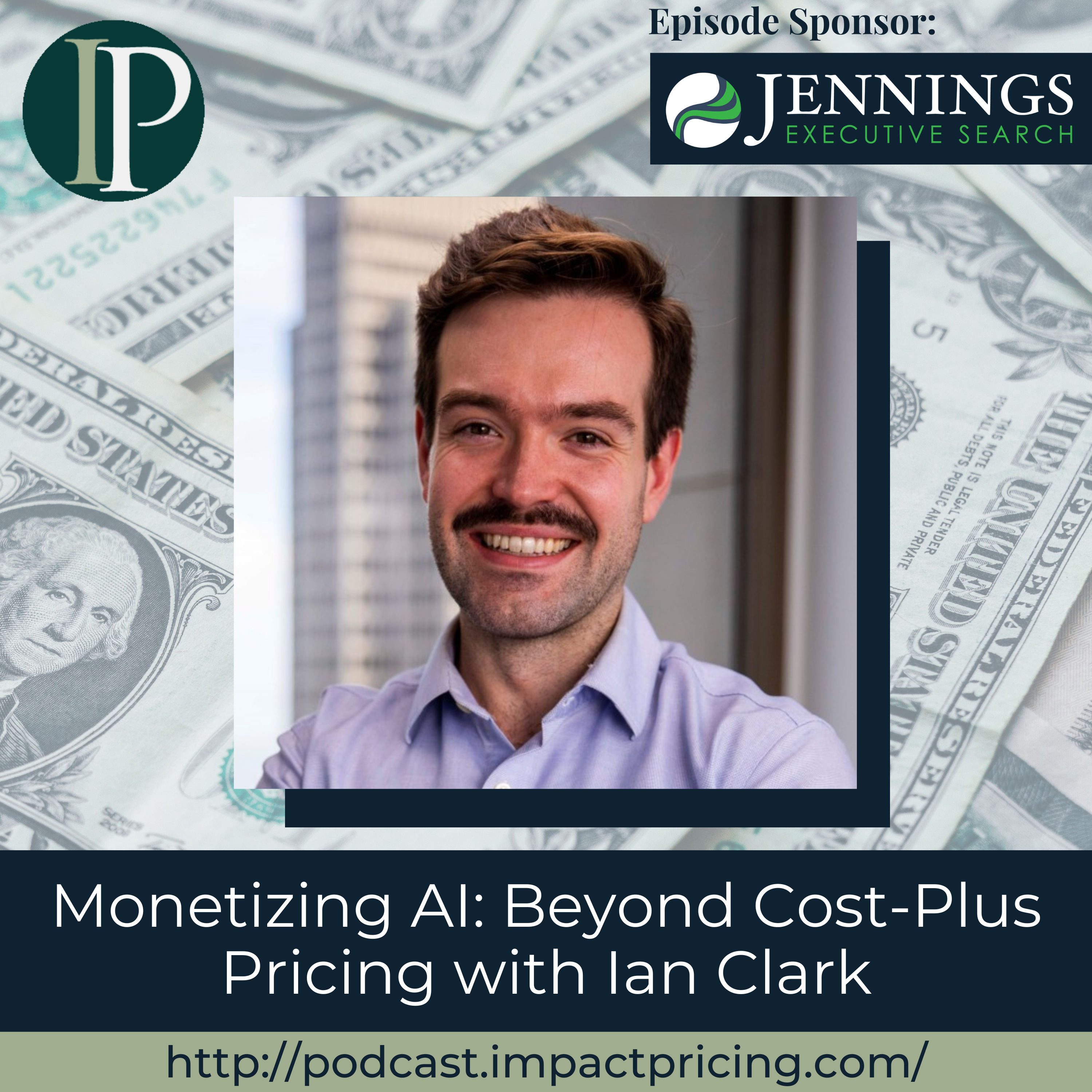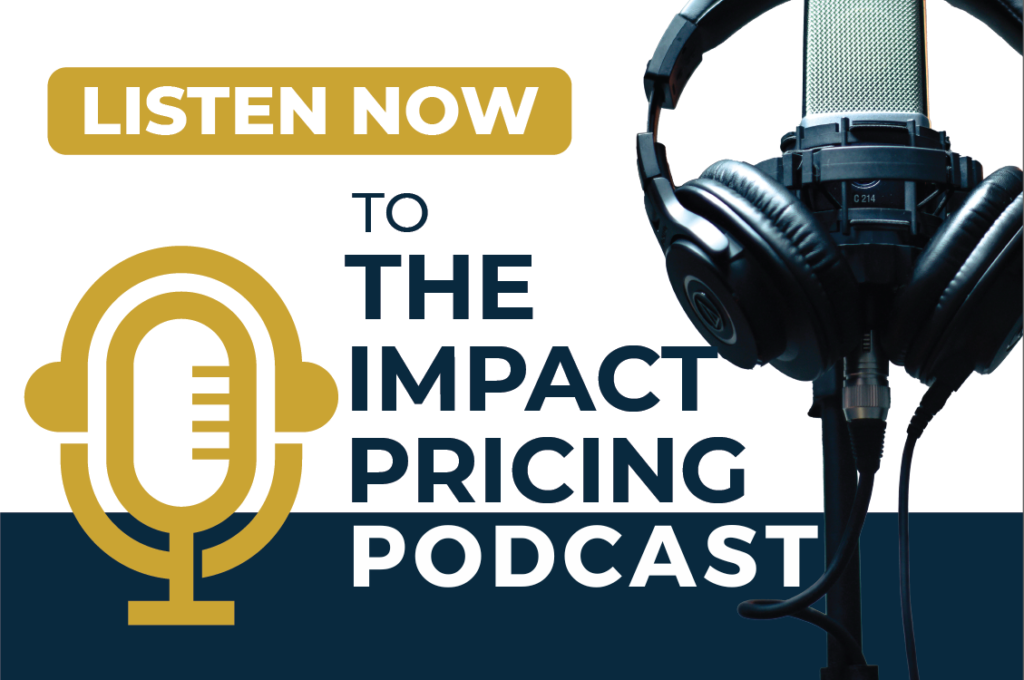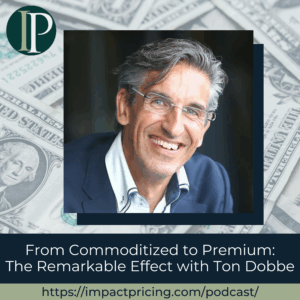
In this episode, Ian challenges common misconceptions about AI pricing, explaining why cost-plus pricing is still wrong even with variable AI costs, how to choose the right pricing metrics beyond tokens, and why outcome-based pricing isn’t the silver bullet many believe it to be.
Podcast: Play in new window | Download
Why you have to check out today’s podcast:
- Understand why AI costs shouldn’t drive your pricing strategy, even when margins drop below traditional SaaS levels.
- Learn how to identify pricing metrics that correlate with willingness to pay rather than falling into the token-based pricing trap.
- Discover why outcome-based pricing for AI faces fundamental attribution problems that make it less viable than expected.
“The best way to get willingness-to-pay data and to understand where the value of your product comes from is by doing customer interviews, not the testing, not the data, customer interviews.”
– Ian Clark
Topics Covered:
02:59 – Monetizing AI vs. SaaS. The surprising similarities between AI and SaaS pricing, and why cost-plus pricing remains a bad idea even with AI’s variable costs.
05:17 – Pricing Strategy in AI.The gross margin threshold where revenue-optimizing and margin-optimizing prices diverge (50-60%), plus the potato chip pricing thought experiment.
09:35 – AI Pricing Strategies.Why token-based pricing is problematic and how to find the right pricing metric that correlates with willingness to pay.
12:24 – Pricing Strategies for AI Tools.Real-world case study of sales enablement AI: choosing between user-based vs. usage-based pricing based on wallet size indicators.
16:27 – Outcomes-based Pricing Skepticism.The attribution problem with outcomes-based pricing and why it’s harder to implement than it appears, using grocery shrinkage AI as an example.
20:11 – Outcome-based Pricing for AI. Sierra’s “resolved conversations” model critique and the ethics of incentivizing AI agents vs. human labor.
24:03 – Pricing and Value Creation.The three-layer value framework: actual economic value → perceived value → willingness to pay, accounting for risk, timing, and budget constraints.
26:39 – 10% Rule in Pricing Strategy.Debunking the “charge 10% of value created” rule with Y Combinator math showing how small variations (9X vs 11X) can dramatically impact company survival.
30:31 – Customer Interviews for Pricing Insights.Why customer interviews beat data analysis and A/B testing for understanding willingness to pay and pain points.
Key Takeaways:
“We have known for a very long time that cost-plus pricing is a really bad idea. And it’s not the case that now suddenly that we have AI, now suddenly it’s a good idea.” – Ian Clark
“So the 10x rule, it’s great, but it’s just woefully insufficient. Why not 11x? Why not 9x? You actually don’t know.” – Ian Clark
“One thing that we like to say about pricing and monetization is that people think it’s like architecture, but it really should be like gardening.” – Ian Clark
Resources and People Mentioned:
- Simon Kutcher Partners: https://www.simon-kucher.com/en
- Alpine Investors: https://alpineinvestors.com/
- James Wilton: https://www.linkedin.com/in/jamesdwilton/
- Sierra: https://sierra.ai/
- Fin AI: https://fin.ai/
- Y Combinator: https://www.ycombinator.com/
- McKinsey: https://www.mckinsey.com/
Connect with Ian Clark:
- Website: https://crescendo.consulting
- LinkedIn: https://www.linkedin.com/in/ian-harrison-clark/
- Email: [email protected]
Connect with Mark Stiving:
- LinkedIn: https://www.linkedin.com/in/stiving/
- Email: [email protected]
Full Interview Transcript
(Note: This transcript was created with an AI transcription service. Please forgive any transcription or grammatical errors. We probably sounded better in real life.)
Ian Clark
The best way to get willingness-to-pay data and to understand where the value of your product comes from is by doing customer interviews, not the testing, not the data, customer interviews.
[Intro / Ad]
Mark Stiving
Welcome to Impact Pricing, the podcast where we discuss pricing, value, and the misunderstood relationship between them. I’m Mark Stiving, and I run boot camps to help companies get paid more.
Our guest today is Mr. Ian Clark. Here are three things you’ll want to know about Ian before we start. He runs Crescendo Consulting, helping companies monetize AI features. He’s advised leadership teams on packaging, pricing metrics, and outcome-based models. And of course, he performed his obligatory stint at Simon Kutcher Partners. Welcome, Ian.
Ian Clark
Thanks, Mark. Good to be here.
Mark Stiving
Hey, it’s going to be fun. How did you get into pricing?
Ian Clark
Yeah. So it’s, I say it’s a long story, but actually I started almost my entire career in pricing. So I started out of college as an entrepreneur, a friend of mine and I, we co-founded an ed tech company and she was more in charge of sales and I was more in charge of the product. As part of that, I needed to start setting prices.
That brought me to Simon Kutcher, where I joined their tech practice and did pricing of software mostly for a few years. Then I ran pricing at Evernote during the turnaround there. I spent a little time as an investor, a venture capitalist, and then most recently I ran the monetization practice at Alpine Investors, which is a mid-market private equity firm. And I started Crescendo a while ago, kind of taking clients while I was in business school, but I only got really serious about it for the last couple of years.
Mark Stiving
Nice. Nice. So the reason we’re talking is someone had said, Hey, you’ve really got to go talk to Ian Clark. And that’s how I often find my guests is it’s like someone else really likes you. Well, now I’m curious, but no, it’s fine. I’m pretty sure it was Anne Marie, but I’m not a hundred percent certain. So let me not say that too loudly.
So I want to talk today about AI. I’m so fascinated as is the whole world fascinated with AI. And what do you see is different when we start talking about monetizing AI versus monetizing SaaS?
Ian Clark
Yeah, so there’s some interesting stuff that is different, but what’s interesting about it is actually how the same it ends up being and how people don’t realize that it’s the same.
So, for example, one of the things that people are commonly talking about when it comes to monetizing AI is that you have to deal with the costs of AI. You have to deal with the fact that your gross margin is going down because you have actual costs to serve. And so you have to somehow price to cost.
We have known for a very long time that cost-plus pricing is a really bad idea. And it’s not the case that now suddenly that we have AI, now suddenly it’s a good idea. And as a matter of fact, a lot of the costs that you see going to AI are pretty minor in the grand scheme of history of gross margins going down. We saw the same thing with cloud and people didn’t freak out about cloud pricing.
So we generally think that just like you would be pricing SaaS, you would want to think about the willingness to pay for AI, not the costs. So that’s the first thing is that there’s this sort of too large of a shift toward cost based pricing that probably is not supposed to be there.
Mark Stiving
Yeah, so let’s take a dive into that for just a second before we find out the next thing that you’re thinking about. So it is fascinating that everybody’s talking about costs with AI. And I don’t know the answer to this, but, you know, I pay for a $20 chat GPT subscription. How much usage would I have to, how much would I have to use that $20 subscription before they start to lose money?
Ian Clark
Yeah. So it doesn’t actually matter how much you personally would have to use it. What matters is, is how much the average person would have to use it. So there are lots of examples where individual customers are unprofitable, but the entire group is profitable. A good example of this be anyone on freemium would be a good example, right?
Mark Stiving
That’s like selling insurance, right? We know that some people are going to be unprofitable.
Ian Clark
Oh, yeah, totally. It’s exactly like selling insurance. The real question is, at what gross margin does the revenue-optimizing price, as in the one that captures the most of willingness to pay, versus the margin-optimizing price differ? Like, at what gross margin do they start to actually diverge?
Now, technically, you could argue that with any variable cost, they’re going to diverge a little bit, but that’s not the point. The point is, at what point do they kind of functionally diverge where we’re actually going to be looking at different price values. And we find that that happens at about 50 to 60% gross margin. You can kind of do the math on that. And it turns out that it’s about 50 to 60% gross margin. And I don’t think there is a chance that most of the AI companies that we’re talking about have 50 to 60% gross margin. Unless you’re doing true infrastructure stuff, you’re not anywhere close to that.
Mark Stiving
Yeah, that’s a fascinating study or fascinating analysis. Here’s how I would push back on that, if I may. So let’s imagine I’m selling potato chips at a grocery store, right? Margin matters a lot when I’m setting a price on potato chips at a grocery store. But that’s partly because, A, the costs are so high, but it’s also partly because I can’t charge different prices to different buyers, or at least it’s really hard to.
And it’s very possible that in the world of AI or in the world of SaaS, we find ways to say, hey, I’m going to do better price segmentation, and I’m not charging you based on usage, I’m charging you based on value, but I know that I’ve captured more of the value from each individual buyer, so I’m covering my cost.
Ian Clark
Yeah, so I think those two things move independently. So we talk about how capturing more percentage of the value that you can do better customer segmentation with, that’s always going to be important. And that’s going to be important whether or not we have the revenue optimizing price as well.
So just to use your potato chip example here. So let’s pretend that I’m selling potato chips and let’s assume this is a big bag so that we can make the numbers work a little bit. I’m selling a lot of potato chips. And I know I have this magic eight ball and I know the demand curve for my potato chips. And it goes, I’ve got 10 customers and it goes 10, 9, 8, 7, 6, 5, 4, 3, 2, 1. Okay. That’s the demand curve for my potato chips.
And the question is, and let’s assume we’ve only got one segment. At what price should I price my potato chips? Now telling you no other information, the answer is five, right? At $5, five people buy it, you make $25. If you charge a dollar more or a dollar less, then you get one fewer person or one more person to buy it, but it ends up being $24. It’s either going to be six times four or four times six.
Mark Stiving
And that’s what we just- So we just maximize revenue.
Ian Clark
You maximize revenue. Okay, now let me introduce a new piece of information. Now I’m going to tell you that I have $5 of fixed costs. Does that change the $5 optimal price?
Mark Stiving
Fixed or variable?
Ian Clark
Fixed costs. Fixed costs doesn’t change it at all. Now I’m going to say, okay, now it costs me $1 to make the potato chips. Does that change the optimal price from a margin perspective? And the answer is yes, it does, but it only changes about 50 cents or so. Like, you know, not very much.
And so that’s what I’m getting at is like, even at an 80% gross margin, where I introduce one whole dollar of cost here on a $5 potato chip, it still doesn’t really move the needle on that optimal price. And then much, you know, that’s the price level. If we’re talking about the structure, and we’re talking about the packaging and the metrics, that stuff is you still definitely want a price to value.
Mark Stiving
Nice. And so what you just gave us a great example of is the fact that the costs, even in AI, they’re not going to matter that much in us coming up with our optimal price.
Ian Clark
Yeah. It’s like we introduced some costs and it makes everybody’s minds go crazy.
Mark Stiving
Yeah, so the way I see it, though, in most people’s minds is it’s easy to blow past normal or reasonable. Maybe. And so it’s mostly these companies that are putting APIs out into their AIs, and they don’t know how many API calls they’re going to get hit with. And so they’re using token-based pricing. Right. And we actually know this is a problem because some people get these really dramatic bills that they didn’t expect to see. And if you assume token based pricing is really cost-plus, that’s really saying, hey, look at the cost. These users just ran up on us.
Ian Clark
Yeah. OK, so you just mentioned two things that are maybe the additional pieces of A.I. pricing that we like to talk about. So the next innovation in AI or the next big trend in AI monetization is the usage of tokens, right? And we at Crescendo are generally not a fan of using token-based pricing.
And number one, it’s because it’s usually just a mask of cost-plus. And then the other one is let’s assume that it’s not a mask of cost-plus, that you’re actually charging for value. Now you have to say, well, what’s one token? Well, one token is equal to 100 rights at a center, right? And then it’s 10 reads at 10 cents a read. And then it’s this plus this plus this. And you end up getting this big formula. And it’s not clear that that is easily understood by the customer any more than just, hey, it’s 10 cents a read, or whatever it would happen to be, or 10 cents a button, whatever that is. So it oftentimes is just far more confusing to the customer than it needs to be to do token-based pricing.
What we’re a fan of is finding out what the primary metric is that correlates with willingness to pay in the usage of that AI and then pricing to that. Sometimes it’s still seats. Sometimes it’s usage. Sometimes it’s capacity. Sometimes it’s something else crazy like time spent talking to the bot or whatever it is. But it really comes down to finding the thing that connects to willingness to pay and then charging for that instead of making up some metric like tokens.
Mark Stiving
Yeah. So by the way, I almost agree with you a hundred percent on that. Yeah. I would say the one thing you missed was outcomes.
Ian Clark
Oh yeah. Outcomes. That’s my third piece. We’ll talk about that. That’s the third one.
Mark Stiving
Oh, okay. As you were going through pricing metrics, I was like, well, you know, outcomes need to be in there too.
Ian Clark
Yeah. Yeah. That’s the third one.
Mark Stiving
And it’s interesting that you say what’s correlated with willingness to pay. And I have to say that I think I agree with that. I always say what’s correlated with value. And so it’s like I have to step back and say.
Ian Clark
So it depends what you mean by value. So when we say value, we think of willingness to pay as utility and wallet size. If value is a proxy for utility, as in how much pain is this thing solving, we definitely find that that’s half of the battle. and you still have to have wallet size.
So a really good example of this is we had a client that had an AI bot that essentially improved salespeople’s productivity because it was doing sales enablement, but for an AI. Now the question is, you could price that based on the usage. When you use more sales productivity, you get more stuff.
But since the value of the AI was essentially a multiplier on every salesperson, you could also make a case that it should be user-based pricing. And that was kind of a toss up. But when you layered in the fact that companies with a ton of salespeople had tons of revenue, sort of definitionally, that was really a good bellwether for whether or not you had the wallet size to pay for this sort of thing. So it ended up being that if you priced to users rather than to usage, the users led to lots more sales through higher contract values, all of the nice metrics that we like to see going up into the right.
Mark Stiving
Yeah. And so, why don’t you think usage would have worked if each salesperson were actually using it? Now, I have reasons why I don’t think it would work, but that’s.
Ian Clark
Yeah. Yeah. So you have to think about the contrapuntal. So you have to say, all right, so we’ve got two companies. So one of them has a small number of salespeople, but they’re using the bot a lot versus a different company that has a ton of salespeople. And they’re each using the bot a little bit. OK. And you have to say which one of those two companies has a higher willingness to pay. And it turns out that the number of salespeople was the thing that was going to swing that further, because the number of salespeople was a better proxy for just the technology budget than was the usage. So obviously, if you have both of them, then we’re good. But the question is, what about corner cases?
Mark Stiving
Yep. Okay. So now, by the way, I hope you don’t mind. I love pushing back. Yeah.
Ian Clark
I do this. I argue for a living. So, you know, excellent.
Mark Stiving
One of the great things about AI is it makes our salespeople, in this case, more efficient, more effective. And so therefore I used to have a hundred salespeople. Now I only need 50 salespeople. Yeah. Thank you very much for charging per user. I appreciate that.
Ian Clark
Yeah, and now we crush the user count. So sometimes that’s true. So a good example is we had a different company out there. This sounds analogous, but it’s actually a very different example. So we had a different company out there, and they have a bot that generates proposals for RFPs. Right. And so there’s a proposal team that’s going to go and do this sort of thing. And what they were finding was you could actually chart the size of the proposal team as shrinking when these companies would get bigger. And so for that company, we did actually recommend, hey, no, this needs to be usage, not users.
So that dynamic is at play. I think the question and the thing that still is out there is, are salespeople actually going to get eaten by AI? And I’m not sure that that particular job where you’re really doing those face-to-face conversations within an enterprise sales context, I haven’t seen that that one is the one that’s going to get eaten by AI. Yes, lawyers, maybe some of these other ones, content, maybe.
Mark Stiving
I don’t know that it needs to be eaten by AI or just make them 50% more effective. You know, if you make a salesperson be able to handle twice as many deals at a time, then we need half as many salespeople to get the same revenue.
Ian Clark
Yeah, maybe that’s true. One thing that we like to say about pricing and monetization is that people think it’s like architecture, but it really should be like gardening. where people like to think they’re going to set up the structure and then go and chase value. But actually, you kind of have to adjust it and garden and prune and cut back and mature these things as the market develops and as the companies develop.
So if that company starts seeing that every company in the world is now reducing the number of salespeople because of all of their technology, then yes, yeah, you would need to do more of a user based pricing. Just thinking, though, historically, We’ve had a lot of sales enablement tools come out in the world in the last 20 years. And I have seen no trend that the number of sales people have decreased from, you know, Salesforce, for instance, coming online or HubSpot coming online, sales enablement, maybe, but you know, not Salesforce itself.
Mark Stiving
Yeah, I think the right metric there would be revenue per salesperson. It’d be interesting to see if I keep the same number of salespeople, but I doubled my company size. That was awesome. Right. Then I got true productivity.
Ian Clark
Yeah, it’s true. So, yeah.
Mark Stiving
Okay. Let’s talk about number three.
Ian Clark
Outcomes. Okay. So outcomes is the third big trend that you see. So the first one that people can talk about costs. The second one is that they say, well, there’s a bunch of different metric innovations. And is there a way to price AI? Which generally we think the answer is no, you could go users, you could go usage, you have to figure out for the dynamics of that company, which is the right choice there, among other ones, but just taking that as an example.
The third is outcomes. So with outcomes, people have this general perception that when you introduce AI to any kind of industry, that now we can finally price to the literal value that we create. And we generally at Crescendo are very skeptical of that. And the reason that we’re skeptical is because there is a problem with outcomes based pricing that has nothing to do with AI. And what that problem is, is that even if you can agree that here’s where the metric was, and then we brought it down to here, or we brought it up, or whichever direction you want the metric to go. Even if we can agree objectively that that’s where the metric is, it’s not clear that the AI is the one that caused that metric to move.
So I’ll give you a good example here. We worked with a company that has an AI that essentially helps you to reorder groceries optimally at your grocery store so that you minimize the spoilage of all of these groceries. You minimize the, you know, raspberries go bad less because you were correct in the timing of your ordering. And the thing is, that’s a very objective metric. It’s called shrink in grocery stores. So we know that it was here. And when we introduced this thing, we brought it down to here.
The problem that we ran into when you would talk to customers is that the customers would say, I see the change in the metric, but I don’t know what percentage of that change I can attribute to your software. For instance, my good management practices. Was it a macro event that happened where now raspberries all just went bad this year because of a hurricane? I don’t know how raspberries grow, but you get the idea, right?
And so, I think that there is this trend that outcomes based pricing is a little bit too trendy and not going to work as much as we think. My example for this is Sierra. So Sierra made a big splash maybe a year ago talking about how they had just implemented outcomes based pricing and two knocks against them. So first off, Sierra is not one of our clients. I don’t know anything about the ins and outs of Sierra’s outcome based pricing, but the first thing I would say is if you take a look at their pricing, it’s not clear that it’s actually outcomes based. And you could just say it’s a proxy for usage.
They price, by the way, as their primary price metric is the number of resolved conversations. So this is essentially when the customer service bot is able to solve your problem rather than punting you over to an actual customer service agent. So if the customer service solves your problem, then Sierra gets paid. OK, that’s the way that it works.
So my first thing is, it’s not clear that that’s not usage based. That is just every interaction that the bot has, that that is a problem. And then my second thing is, I have not talked to too many people who would be super excited to have that as their price metric. Because if you think about it, Can you think of any example where a customer might say, speak to a representative like as soon as they get on the phone with someone? I certainly can. And so, yeah, it’s not clear that that is a solution or something being solved there. And I’m sure that they’ve thought of this, but I worry about that price metric as being like outcomes based. All right, push back now.
Mark Stiving
So let me push back just a little bit in the following sense. First off, me and everybody that I hang out with uses Fin.ai all the time as an example of this. And my expectation is that if someone says representative, it goes straight to representative and Fin.ai didn’t get paid. It wasn’t an outcome, it was just a conversation. It was usage that didn’t get paid. And I would say that they get paid when the customer never talked to a customer service rep.
Ian Clark
What if they didn’t solve the problem?
Mark Stiving
What if you just gave up? The customer would talk to a customer service rep.
Ian Clark
You’re relying on customers talking to the rep, like going through it, through the flow?
Mark Stiving
Or I don’t know FinAI’s product well enough or Sierra’s product well enough, but I would guess that at the end there’s probably a did we solve your problem question. And they say yes or no.
So here’s the thing that’s interesting about outcomes. And by the way, I don’t disagree with anything you said. The description you made on who gets credit, I’ve always thought that when I was thinking, well, the pricing department should get credit when we raise prices and we get more revenue. But it’s like, no, no, no. Sales says they did a better job and marketing says they did a better job. And so it’s the same problem we’ve seen for a long time in different areas, different respects. And so it feels to me like outcome-based pricing for AI is really only going to work for agents when it isn’t trying to help a person be more effective. It’s really, we’re going to take on this role and do the job for you. Right.
Ian Clark
Yeah. And if that’s the case, let’s pretend that for whatever reason, you had an AI that was processing credit card transactions, right? You say, Hey, for every credit card transaction that this agent processes, we’re going to take a cut of it. It’s not clear to me that that’s materially different from Stripe’s current pricing today, which is just usage. Right.
So the key thing with with A.I. is like, no, no, no, I’m taking a percentage of the business outcome I’m driving, whether that’s revenue or costs or something. And it seems unlikely that A.I. is going to be able to do it. My favorite example of this is if A.I. is a proxy for human labor, which I think it is, I think it’s just scaled human labor in a certain way. If AI is a proxy for human labor, could you as a human actually price to that price metric? So let’s say I am your customer service rep. I am your person. And I say every time that a person talks to me and they don’t get to you, I get $5. you might start to wonder if maybe I’m just punting them in the wrong direction.
Mark Stiving
Okay. So now we’re talking ethics issues. I see way too much of that. Okay. Excellent. So what else do we want to know about when we think about monetizing AI?
Ian Clark
Well, it really comes back to those what I was talking about with the first principles. So it’s don’t worry about cost as much as you think you are. Don’t worry about what people are doing generally writ large about how to monetize AI. Think about it from your company’s perspective. What’s that thing that is going to be correlating to value the most or willingness to pay? And then the last thing is it’s really hard to take a percentage of the business value that you create. Even if you could calculate the business value you create, there are very few companies out there that can take a percentage of that value. So I would say, before you walk down that path and try to do that sort of trendy thing, try something more standard to make sure that you even just are creating value for those customers.
Mark Stiving
Yeah, so let’s talk for a second about what does value mean and pricing, if that’s okay. Yeah, let’s do it. So just gonna be AI or not AI doesn’t matter to me. Yeah. If I’m gonna price something to a customer, what I really wanna know is how much value am I creating for that customer. Sure. In the world of B2B, which it seems like you work in as well as I do, in the world of B2B, I define value as incremental profit. Right. How much more money am I going to make you because you’re using my product and you’re not using my product.
Ian Clark
Yeah.
Mark Stiving
And so when we price, we’re still pricing to that profit number. Yeah. And what we have to do is convince a buyer they’re going to get more money. They’re going to make more money when they buy our product. So somehow we have to bring our price to that profit.
Ian Clark
I wrote a post about this, and I have to steal this framework from James Wilton over at Monovate. I did not invent this, but I think it’s brilliant, which is if you think about there is the top level here is the actual economic value that you create. You saved this much to your employees, this much time, you got this many more customers, you reduced your ad spend. At the very top, there is the actual number that you create, but you have to take a haircut off of that. Because the haircut you have to take is that the customer doesn’t always believe or they can’t always see that you created that amount. So there’s a difference between the actual value and then the perceived value.
But even if the customer perceives that this is the value that you create, you actually have to take a haircut off of that to get to willingness to pay. because there’s a couple things. First off, there’s risk. So let’s say that you do create this value, but there’s a variance in that value. There’s risk involved there. Well, they have to be paid for that risk. There’s time value of money. So maybe they have to make an investment and they don’t see that value for a while. And so then they have to deal with that. And then there’s budgetary constraints.
So there’s actually three layers before you even get down to willingness to pay. And then that’s the maximum you could even ever charge. Then you have to create a price that gets up as much as possible to that number. And that’s where most of the work we do is trying to figure out how can you capture as much of that value as possible. Yeah, of course, you’re always going to want to say, hey, let me explain to you how we created value for you. And obviously, you’re always going to want to raise that top line. But we find that raising that top line doesn’t always answer the whole question.
Mark Stiving
So that makes sense to me. And the number that I always use, I don’t know if you have one of these in the back of your head or not, but I always use that if a customer believes they’re going to make a million dollars.
Ian Clark
Yeah.
Mark Stiving
I could sell my product for a hundred thousand. Right. I’m expecting 10% of that.
Ian Clark
Oh my gosh. I love that you brought this up. I love that you brought this up. Okay. You are not the only person to have said this. If you go back and you look at the Y Combinator archives, there is an old YouTube video from one of the Y Combinator partners who’s not at the firm anymore, but talking about what he called the 10% rule or the 10X ROI rule. Okay. So this is one of my favorite examples. So I’m so glad that you brought this up.
So let’s pretend that it is actually that amount. All right. And I use the Y Combinator example here. We wrote a big post about this and I use that math to actually run through this. So let’s pretend that you raised, I think it’s like $250,000 or whatever the Y Combinator check is, and you’re going to have to raise your seed in two years. Admittedly, we’re going down smaller companies here. The difference between saying it’s 9X versus 11X. So you said, oh, it’s 10X ROI. What if you’re wrong? What if you’re wrong by just one turn? 9x or 11x? And by the way, that’s not that much. What if you’re wrong by that amount?
If you do that with the Y Combinator math, the difference in length of like the burn rate of the company, the lifetime of the company is the entire life of the company. So the difference between a 9x and an 11x in terms of the price that you would get and therefore the revenue that you would get is something like 23 months or something like that. And when the company only has 24 months to live, that range is massive. It’s not nearly enough. So the 10x rule, it’s great, but it’s just woefully insufficient. Why not 11x? Why not 9x? You actually don’t know. And what you end up having to do is, I say that I’m gonna create a million dollars for you. What is your willingness to pay for that million dollars? It might be $100,000, but it might not be. You got to figure that out.
Mark Stiving
I’m totally with you. I would price every customer differently based on what I thought their willingness to pay would be. But the key point in my mind is, look, just because I can prove that you’re gonna make a million bucks doesn’t mean I’m gonna get a million dollars. It doesn’t mean I’m gonna get a half a million dollars.
Ian Clark
If I were sitting here and I said, hey, I’ve got $100 in my pocket and I’m gonna give it to you, how much are you gonna pay for it? And now we introduce the fact that we’re talking over Zoom or over the podcast player and now maybe it’s a little bit different. Or maybe it’s, I’m not gonna pay it to you today, I’m gonna pay it to you in two months. And now it’s a little bit different. And so all of these things bring it down from I would be willing to pay 99.99 all the way down to maybe 10%. Yep. Yep.
Mark Stiving
Yeah. I often use a McKinsey example, but I was working for a company once and McKinsey comes in and I’m not joking. This was essentially the sales pitch. We’re going to make you $20 million. It’ll only cost you 3 million. Right. And so they’re getting 15%. They’re asking for 15%. Yeah.
Ian Clark
Oh, it’s a great sales pitch. Sorry. Let me, if you can 10 X your money, what an amazing ROI to underwrite to. If you’re a company and you’re going to do some capital allocation toward that idea. Awesome. Wow. What a great ROI. What I’m saying is that’s not a good way to price it. Right.
We have this client that was in the healthcare space and they actually had amazing data about how much money they would create for their customers because it was just kind of publicly available data and tons of statistics about patients. And they would come to companies and say, here’s how much money we’re going to make. We take 10%. And the question that we kept asking was, why 10%? Why not 11%? Because the difference between 10 and 11% is like five X-ing your EBITDA in this company’s example.
Mark Stiving
Yep. Yep. Excellent. Excellent. Ian, I think I could talk to you all day, but we’re out of time. Let me ask you the final question anyway. What is one piece of pricing advice you would give our listeners that you think could have a big impact on their business?
Ian Clark
Talk to your customers. Everybody tries to do pricing by doing data analysis, or they try to do pricing by doing A-B testing or sales testing in a B2B case. And the best way to get willingness to pay data and to understand where the value of your product comes from is by doing customer interviews, not the testing, not the data customer interviews.
Mark Stiving
And I’m curious, what do you ask on your customer interviews?
Ian Clark
Oh my God, so many things. So, how much time do we got?
Mark Stiving
Well, we’re out of time, but give me two or three examples.
Ian Clark
So my favorite things to ask in customer interviews are really to explore the pain, actually, from the customer’s point of view. What is this pain and how much is that pain worth to you? I don’t ask it that way, but that’s how you would do it. When you find out the source of the pain, then that informs so many things from price metric all the way down to the actual price level. There are some tips and tricks that you can do to get at price sensitivity that you can get in customer interviews and willingness to pay, actually, if they’re going through an entire exercise with you. But there’s a longer, more advanced version, I’ll say.
Mark Stiving
Nice, nice. Ian, thank you so much for your time today. If anybody wants to contact you, how can they do that?
Ian Clark
Yeah, easiest way you can reach me, my email address is ian, I-A-N, at crescendo.consulting. So C-R-E-S-C-E-N-D-O.consulting. That’s also our website, crescendo.consulting.
Mark Stiving
Perfect. Thank you very much. And to our listeners, thank you for your time. If you enjoyed this, would you please leave us a rating and a review? And if you have any questions or comments about this podcast, or if your company needs help getting paid more for the value you deliver, feel free to email me, mark at impactpricing.com. Now go make an impact.
[Ad/ Outro]















